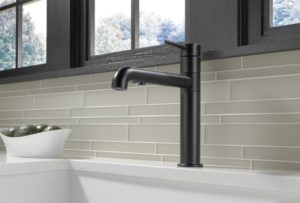There is a lot to choose from when it comes to kitchen sinks – material, style, size – and that’s before you get to faucets and accessories. Your kitchen sink might be the most utilized fixture in
your home. It’s got to work for you, you’ll be spending a lot of time with it! Part one of our primer deals with the different types of kitchen sink materials. Let our guide give you a starting point. Let your style, needs and budget dictate your decision.
Stainless Steel

Probably the most popular material. You can find a stainless steel sink in any size, type or style and are heat and stain resistant and very durable. Stainless steel can also be one of the more affordable sink materials. One complaint has been that water marks and scratches can be noticeable. Try a brushed or satin finish rather than a mirror finish to alleviate this. You should also consider a stainless steel sink with a sound-absorbing pad on the bottom, which can reduce noise.
Cast Iron

Cast iron sinks are iron alloy with a porcelain or enamel finish to give them a smooth, glossy look. Cast iron sinks are very durable but are usually very heavy. Make sure your cabinets or supporting mount is capable. Cast iron sinks are most often white, but can be found in other colors. They are also usually associated with apron or farmhouse styles.
Composite

Composite sinks are often made from quartz or granite mixed with an acrylic binder. They are among the most durable choices with scratch, heat and chip resistance. They look good and are available in many designer colors to match any design scheme or aesthetic.
Fireclay

Fireclay sinks are manufactured from molding ceramic clay into a sink shape and firing at an extremely high temperature. Porcelain enamel is applied and the sink is fired again. This process makes fireclay sinks very strong and considered more durable than cast iron. Fireclay sinks can be on the expensive side versus other sink materials. But they are very resistant to scratched, staining and chipping. Maintenance is easy – soap or cleaner used with sponge or mild abrasive cleaner.
Copper

One of the most distinctive materials for a kitchen sink, copper sinks can have a smooth or a hammered finish. Copper sinks are rust-resistant and antimicrobial, making them a modern choice. As long as the sink you choose if at least 99% pure copper – a small amount of zinc might be added for strength. Coast your copper sink to preserve the stereotypical copper color. Otherwise after exposed to air and water, your sink will develop a patina – which can be a plus! However copper sinks are more expensive than other sink materials and you’ll need to maintain it – washing with soap and water and drying thoroughly to keep it’s finish intact.
Bamboo

The eco-friendly option. Bamboo sinks are made of solid bamboo slabs put together to form a sink bowl, and then sealed. They CAN leak if not maintained. Wash bamboo sinks with mild soap and a soft sponge or cloth and be sure to wipe off/dry excess water to eliminate the risk of water spots and residue buildup. Do not use harsh chemicals or cleaning agents. No two bamboo sinks look alike, and a bamboo sink can be a beautiful addition to your kitchen.


